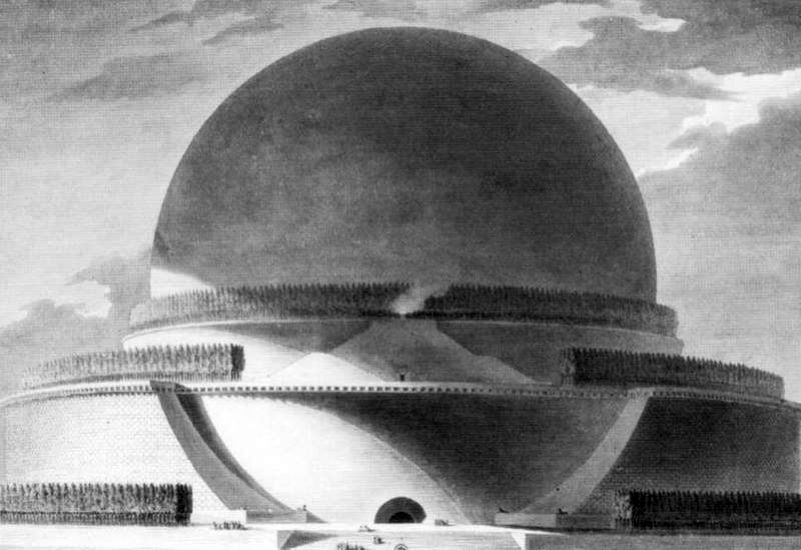At the height of the Enlightenment, architects in France turned to an architecture that attempted to use pure forms, such as pyramids, cylinders and spheres, with a new rationality, as if applying the notion of reason to building. Their influence spread beyond the Age of Reason itself to inspire a very different generation of artists and thinkers.
For many, the 18th century was the Age of Reason and the time of the Enlightenment—the cultural movement that embodied free-thinking, skepticism and scientific thought. The thinkers of the Enlightenment looked back to the great rational scientists and philosophers of the 17th century, figures such as Descartes in France and Newton in England, and valued a combination of scientific understanding and free thought. They included writers such as Voltaire and Rousseau, and their watchwords were reason and rationalism.
From neoclassicism to pure geometry
When the Enlightenment philosophers were flourishing, the prevailing architectural style was neoclassicism. In many ways it must have seemed an appropriate style, highly ordered, adaptable to virtually any type of building and not closely associated with the Christian religion, which some of the philosophes rejected. A classical library seemed an ideal setting for Enlightenment inquiry; a classical drawing room a perfect place for a philosophical discussion between colleagues or friends.
But there were some architects who wanted to take further the link between architecture and ideas. They aimed to create buildings that were a three-dimensional embodiment of the geometry and mathematics that underlay the philosophical ideas of the Age of Reason, in the process thinking every structure through from first principles. These architects, Frenchmen Etienne-Louis Boullée and Claude-Nicholas Ledoux, produced buildings—or at least designs, since not all these projects were actually built—that resembled nothing seen before or since.
The Sublime
First explored in an anonymous ancient Greek text, On the Sublime (said to be by Longinus), the idea of the sublime became especially popular in the 18th century. The Sublime encompasses ideas of the awe inspired by vast phenomena (especially natural phenomena) and the strong emotions associated with religion.
The idea was discussed by the British philosopher Edmund Burke, analyzed by the German Immanuel Kant, and influenced several art forms, especially literature (where it resided in the emotions engendered by wild scenery or the vastness of the cosmos) and painting (where it influenced both the imagery of landscape painting and of canvasses depicting supernatural subjects, such as ghosts). In architecture structures such as Boullée’s Newton Monument (above), for all their rationality, show in their vast size the influence of thinking about the Sublime.

Boullée’s geometrical forms
The most shocking of these structures were designed by Boullée and his most famous design is a monument to one of the fathers of the Enlightenment, the British scientist Isaac Newton. Boullée’s Newton monument was to be in the form of a hollow empty sphere 152 meters (500 ft) in diameter. The upper part was to be pierced with holes so that tiny pinpricks of light would shine through like stars. There was also to be a lamp suspended from the ceiling, to represent the sun. Boullée, in other words, was proposing a vast model of the universe to commemorate the person who had done most to explain how the cosmos works.
Not surprisingly, Boullée’s vast Newton monument was never built. Neither was his royal library, with its terraces of books inside an enormous cylindrical shape. Nor were other structures he proposed in the form of outsize cones or pyramids. They remained on paper, as extraordinary workings-out of ways of using “pure” forms to make unprecedented buildings.
Frozen music
The great German Romantic writer Johann Wolfgang von Goethe produced one of the most memorable metaphors when he described architecture as “frozen music.” The phrase suggests that buildings have the ability to inspire emotions and to grip the imagination, just as music does, but that they are also frozen in time. This resonant phrase points to both architecture’s symbolic power and to its ability to overwhelm the beholder, in a way that is similar to the works of the French Enlightenment designers.
Ledoux’s architecture parlante
Less outré than Boullée, and more successful at getting his projects built, was Claude-Nicholas Ledoux. He was the architect of a set of 50 toll gates around the edge of Paris (four of which still stand) and of the extraordinary Inspector’s House at the source of the River Loüe, a structure designed in part as a cylinder through which the river gushes in a continuous waterfall. It is hard to imagine a closer unity of purpose and structure, and the house illustrates Ledoux’s notion of “l’architecture parlante,” an architecture that speaks its purpose.
“Ledoux refused to accept either Palladio or the Greeks. He … wanted to re-think the problem, and re-feel the character, of every job.” Nikolaus Pevsner, An Outline of European Architecture
Ledoux’s masterpiece is the Royal Saltworks at Arc-et-Senans near Besançon. The house for the Director of the Saltworks, its entrance portico dazzling with tall, rusticated coloumns, is a show-stopping building. But still more remarkable was the “ideal town” of Chaux that Ledoux planned to complement the Saltworks. Around the works was an oval of houses for the workers, beyond this an array of public buildings: a catacomb in the shape of a vast sphere; the Pacifère, a building where disputes would be settled; temples of Memory and Virtue; and a Temple of Love planned in the shape of an erect penis.
Beyond reason
For all their symbolism, though, these buildings go beyond rationality. Their very vastness, not to mention their sheer nerve, inspires awe in the beholder. So, as well as looking back at the Age of Reason, these designs also look forward to the fascination with powerful natural forces that characterized Romanticism, the cultural movement that emphasized the individual artist, and that took pleasure in contemplating the great spectacles of nature—from mountains to waterfalls—and the emotions they inspire in humankind.